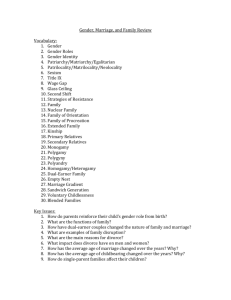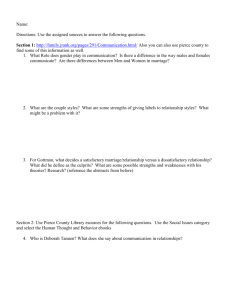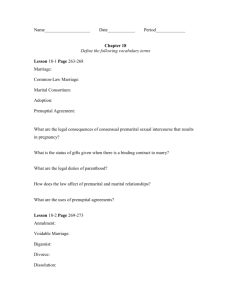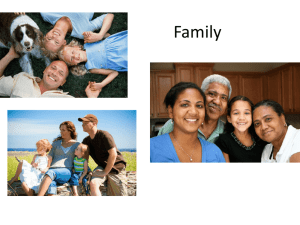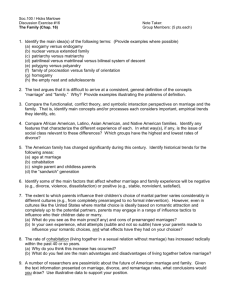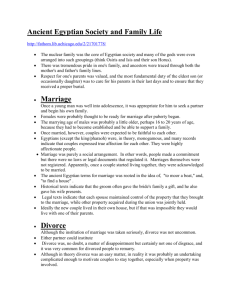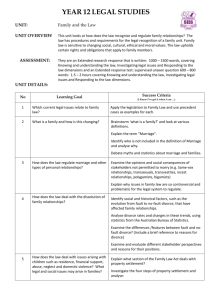Chapter 14 - FacultyWeb
advertisement
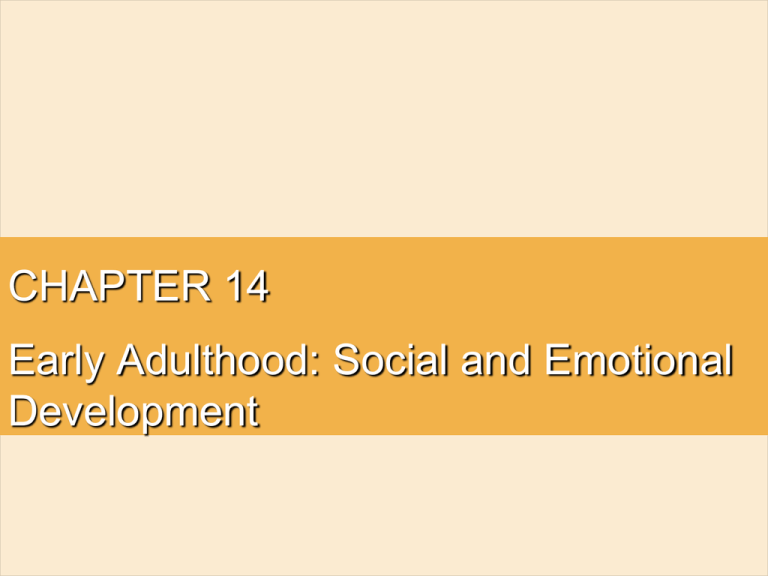
CHAPTER 14 Early Adulthood: Social and Emotional Development Early Adulthood • Spans the decades from ages 20 to 40 • Havighurst tasks* (1972) – – – – – – – Getting started in occupation Selecting and courting a mate Learning to live contentedly with one’s partner Starting a family and becoming a parent Assuming responsibilities of managing a home Assuming civic responsibilities Finding a congenial social group *This traditional view ignores some realities of human diversity and contemporary life. Separation Separation • Young adults leave home at different ages and for different reasons. • Healthy for young adults to separate from their parents • Some young adults may live at home longer to save money until they can live on their own. • Young adults who go away to college often have a room at their parents home. • Even some college graduates may return home to live for financial reasons Separation (cont’d) • Young adults in the military have housing needs taken care of; rupture from home and neighborhood is sudden and complete • Many working young adults live at home for financial reasons. • Not uncommon for some young adults to get married and then move in with one set of parents – Sometimes tolerant parents will let unmarried child move in with them along with a boyfriend or girlfriend Separation - Individuation • Individuation – Becoming an individual by means of integrating one’s own value and beliefs with those of one’s parents and one’s society • Men – Most men consider separation and individuation key goals to personality development – Males more likely to show struggle or fight for independence • Women – Most women consider social relationships of primary importance • Employment and financial independence lessen feelings of connectedness with parents. – College maintains these feelings Intimacy versus Isolation Intimacy versus Isolation • Erikson (1963) saw establishment of intimate relationships key “crisis” of early adulthood • Young adults with firm identity seek to fuse relationships into marriage or abiding friendships. • Erikson believed it is difficult to commit to others until ego identity is achieved. • Erikson believed it was normal to develop intimate relationships and bear children within a generally stable and nurturing environment during early adulthood. Seasons of Life Levinson’s Seasons of Life • Levinson hypothesize that adults go through certain periods of life called “seasons”. • Believed the underlying pattern of a person’s life was his or her life structure - Adopt the dream to become someone, leave mark on history - Women - Undergo similar development but with social constraints both from families of origin and society, making it harder for women to leave home - More pressure on women to go from parents’ home to husbands’ home Seasons of Life (cont’d) - Age 30: transition (ages 28 to 33) - Characterized by reassessment for both men and women - Later 30s - Characterized by settling down or planting roots - Financial and emotional investment in home - Concerns focus on career advancement, mortgages, and raising their own families - Some of Levinson’s views outdated by U.S. standards - Many women lead independent, single lives as long as they wish - Most do not care what others think of their status or living arrangements - Most will live in cities where others do not frown on their lifestyle Attraction and Love: Forces That Bind? Attraction and Love: Forces that Bind? • In developed nations, young adults are free to choose with whom they will associate as well as with whom they will develop romantic relationships. • Attraction and love – The emotional forces that fuel these associations Attraction • Attraction: psychological forces that draw people together • Physical appearance is the key factor in consideration for partners for dates, sex, and long-term relationships. • Culture is a determinant as to which qualities are attractive – In some African tribes, long necks and round, disk-like lips are signs of feminine beauty. – In U.S., taller men are considered more attractive by women. – In U.S., there is pressure for both males and females to be slender. – Experiments in which men rated the same woman as being more attractive when her photograph was shown against a red background as compared with white, gray, and a variety of other background colors Sex Differences in Perceptions of Attractiveness • Women more attracted to socially dominant men than men are attracted to socially dominant women. • Outgoing men found to be more attractive • Men put off by outgoing, self-expressive women • Tall women not seen as attractive; opposite true for tall men • Women more likely to marry an unattractive male – Not likely to marry an unemployed male (Sprecher, 1994) Are Preferences Concerning Attractiveness Inborn? • Evolutionary psychologists maintain certain traits more attractive due to reproductive advantage • Cleanliness, good complexion, clear eyes, good teeth, good hair, firm muscle tone, and a steady gait universally appealing to both sexes – Possibly markers of reproductive potential • Biological clock limits females’ reproductive potential • Physical characteristics associated with women • Ability to provide for family associated with men Table 14-1, p. 293 The Attraction-Similarity Hypothesis: Do “Opposites Attract” or “Do Birds of a Feather Flock Together”? • Attraction-similarity hypothesis – People develop romantic relationships with others who are similar to themselves in attractiveness and other traits. • Opposites do not attract – People in committed relationships are most likely to be similar to their partners in attitude and cultural attributes. – Partners are like us in race and ethnicity, age, level of education, and religion Reciprocity: If You Like Me, You Must Have Excellent Judgment • Reciprocity – When we feel admired and complimented, we tend to return these feelings and behaviors. – Important determinant of attraction Love • Romantic love occurs within a cultural context in which the concept is idealized. • Concept of love in Western culture is transmitted through romantic fairy tales that are passed down through the generations. Love as Appraisal of Arousal • Love – State of intense physiological arousal – The cognitive appraisal of that arousal • Perception of being in love consists of – 1) state of intense arousal that is connected with an appropriate love object – 2) cultural setting that idealizes romantic love – 3) attribution of arousal to feeling of love for the person Sternberg’s Triangular Theory of Love • Sternberg’s (2006) “triangular love” theory consists of three building blocks – 1) Intimacy — the experience of warmth toward another person that arises from feelings of closeness and connectedness, and the desire to share one’s innermost thoughts – 2) Passion — intense romantic or sexual desire, accompanied by physiological arousal – 3) Commitment — desire to maintain the relationship through good times and bad • In this theory, couples are well matched if they possess corresponding levels of passion, intimacy, and commitment Sternberg’s Triangular Theory of Love (cont’d) • Being in love – Refers to states of passion; friendship is based on shared interests, liking, and respect; do not necessarily overlap • Romantic love – Has passion and intimacy but lacks commitment • Fatuous love – Has passion and commitment but lacks intimacy; usually dies down when couple realize they’re not well matched • Consummate love – Relationship with passion, intimacy, and commitment Fig. 14-3, p. 295 Jealousy • Partners become jealous when others show sexual interest in their partners or when their partners show interest in another. • Jealousy can contribute to a relationship failing. – Can cause feelings of insecurity and rejection, anxiety and loss of self-esteem, and feelings of mistrust • Milder forms of jealousy can show that the partner cares. • Young adults have been known to play jealousy games. Loneliness Loneliness • Loneliness – Increases during adolescence when peer relationships replace family ties and teens are more aware of other adolescents becoming more successful at making friends and earning the admiration of others – Associated with low self-confidence, introversion, unhappiness, depression; social support helps people to cope with stress – Social isolation contributes to health problems such as obesity and high blood pressure. – Lonely people may have poor social skills or lack empathy. The Single Life The Single Life • Young adults – More are choosing to remain single longer than young adults from previous eras – Many are postponing marriage to pursue educational and career goals – More are living together • More families are headed by single mothers. • There is less stigma today associated with being single than in the past. • Singles report loneliness and a desire for a steady, permanent relationship. The Single Life (cont’d) • Most singles are well adjusted. • Many singles obtain emotional and psychological security through a network of intimate relationships. • Many singles practice serial monogamy. • Some have primary sexual partner and occasional flings • Some choose celibacy for religious reasons, to focus on work, to keep from getting an STI, or because they find sex unalluring Cohabitation: Darling, Would You Be My POSSLQ? Cohabitation: Darling, Would You Be My POSSLQ? • POSSLQ – People of Opposite Sex Sharing Living Quarters – Applies to unmarried couples who live together • Less stigma for couples living together • Cohabitating partners tend to marry – Have a 40% chance of divorce later on • Reasons for cohabitating vary • Cohabitating couples less committed than married couples – Less religious Figure 14-4 p299 Figure 14-6 p300 Marriage: Tying the Knot Marriage: Tying the Knot • Marriage most common lifestyle among young adults entering midlife • Marriage – Legitimizes sexual relations – Provides an institution in which children can be supported and socialized – With marriage, one can assume the children had within the marriage are theirs – Marriage transmits wealth from one family to another and one generation to another – Provides sense of security and opportunities to share feelings, experiences Types of Marriage • Monogamy – Marriage between one person and another person • Polygamy – Person has more than one spouse (of the other sex) and is permitted sexual access to each of them • Polygyny – Males are permitted to have multiple wives as in Islamic societies • Arranged marriage – Families of the bride and groom more or less arrange the union of their children; found in traditional societies such as modernday India • Gay marriage and Civil Unions – Marriage between two males or two females Whom Do We Marry: Are Marriages Made in Heaven or in the Neighborhood? • Young adults tend to marry others from the same area and social class. – Cinderella’s story is an exception to the rule • Young adults marry others similar in physical attractiveness, background, and interests. – Similar in height, intelligence, educational level, religion, even similar in alcohol and tobacco use • Homogamy – “Like marrying like” – These marriages tend to be more stable • Age similarity prevalent in young adulthood – People marrying late or remarrying tend not to select partners so close in age Marital Satisfaction • Quality of the marriage affects physical and psychological health • Satisfaction with career associated with satisfaction with marriage – Both related to general life satisfaction • Heavy drinking leads to decreased marital satisfaction • Marital satisfaction decreased with the birth of a child Parenthood Parenthood • Parenthood is being delayed until late 20’s • Most people choose to have children for personal happiness or well-being. • People in traditional societies report having children to – – – – – – strengthen marital bonds provide social security assist with labor (as in having more hands to help on a farm) maintain family lineage; secure property rights and inheritance improve odds of reincarnation care for one in old age Parenthood and Role Overload • In developed nations, conflict and depression may occur when the mother has to return to work shortly after the birth of the baby. • Mother is still primary caregiver – Encounters role overload • Not as much stress when parents agree on beliefs about parenting, role assignment Parenthood in Dual-Earner Families • Mothers in dual-earning families encounter more stress than fathers. • Dual-earning mothers show a decline in well-being, while men show an increase. • Dual-earning mothers with flexible work schedules have less stress than women with fixed schedules. • Problems in the workplace translate to problems at home. • Mother typically cuts back on work or drops out of workforce Divorce: Breaking Bonds Divorce: Breaking Bonds • Divorce rates in U.S. between 40% and 50% • Divorced men more likely to remarry than divorced women • No-fault divorce laws have helped to aid in the increase in divorce. • Americans today expect more from marriage than past generations. The Cost of Divorce • Divorce tends to affect women more than it affects men. • Women’s household income drops by 24% – Men’s household income drops by 6% • Formerly non-career-oriented women often compete for jobs against younger, more experienced women. • Divorced women tend to have sole responsibility for the children. • Divorced fathers may find paying alimony and child support difficult while establishing a new lifestyle. The Cost of Divorce (cont’d) • Divorce may cause feelings of failure as a spouse and a parent; children do suffer from divorce. • May increase loneliness and uncertainty about the future • Divorced and separated people have the highest rates of physical and mental illness. • Benefits of divorce – May permit personal growth and renewal – Can be an opportunity to take stock of oneself and establish a new, more rewarding life
